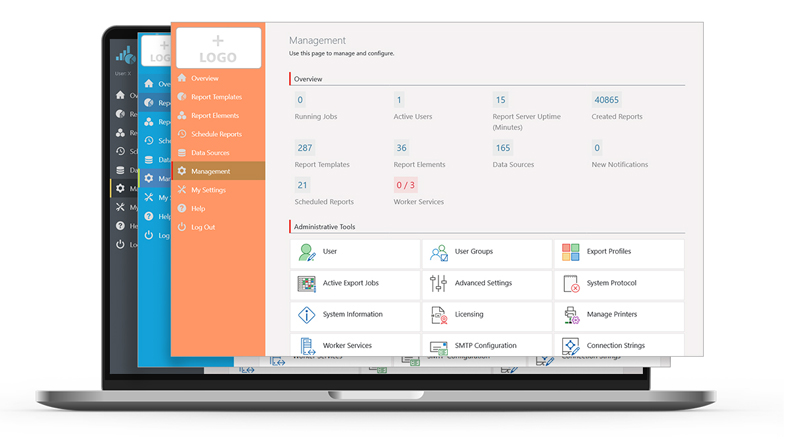
Die bisher beliebtesten Kundenwünsche drehten sich meistens um die Anpassbarkeit der Oberfläche. Das Ziel war dabei meistens identisch: Der Report Server sollte auch optisch in eine bestehende Infrastruktur (Anwendungen) integriert werden können. Im Allgemeinen Sprachgebrauch ist dieses Feature auch unter “Whitelabeling”, “White Label Support” oder “Custom branding” bekannt. Sie finden das neue Feature in der Verwaltung unter “Optik / Erscheinungsbild”. Hier lassen sich diverse Farben und Logos/Banner anpassen oder wieder auf ihre ursprüngliche Einstellung zurücksetzen.
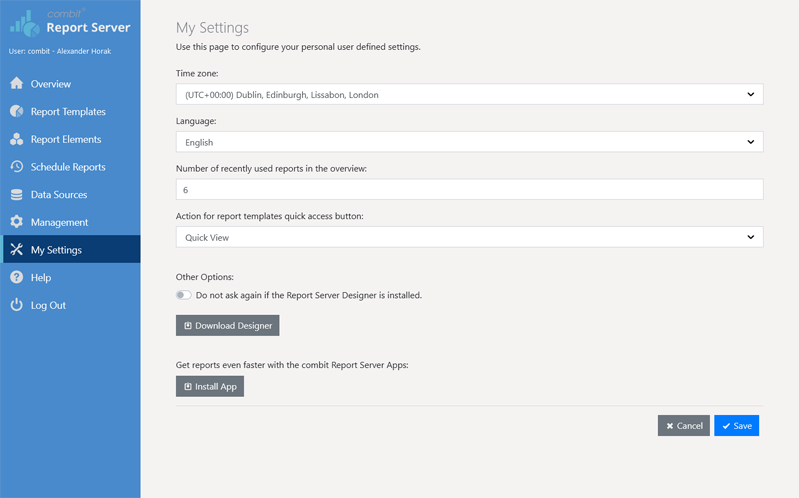
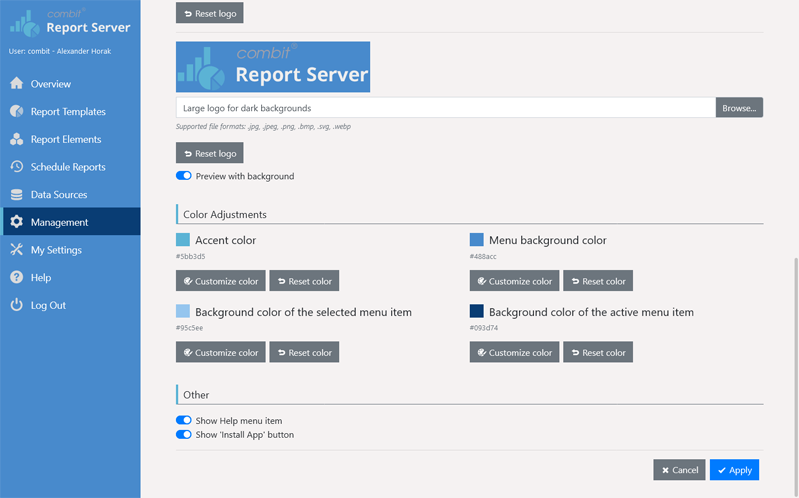
SFTP Aktion
Für geplante Berichte gibt es eine neue Aktion. Das SSH “File Transfer Protocol” sorgt für einen sicheren Transfer von Daten zu einem Server. Dabei stellt das SFTP eine Alternative zum bereits vorhandenen FTP mit verbesserter Sicherheit dar.
Berichtsvorlagen haben eine Sprache
Ab sofort können Sie in den Berichtsvorlagen eine Sprache auswählen, die List & Label beim Druck verwenden soll. So können Sie z.B. bei einer deutschen Systemsprache (Server) die Berichtsvorlage als Englisch drucken. Dadurch passt sich automatisch die Formatierung an oder Sie können abhängige Übersetzungen mit einer Formel anbieten.
Standardmäßig verwendet eine Berichtsvorlage immer die Systemsprache (vom Server), sofern nichts anderes ausgewählt wurde. Diesen Standard können Sie mit dem entsprechenden “Systemsprache”-Eintrag wiederherstellen. Die Liste hat eine einfache Suchfunktion, um die gewünschte Sprache zu finden.

Beispiel zur Verwendung im Designer:
LangCase$("Hello (Default)", "de=Hallo|en=Hello|es=Hola")
Es kann auch über LL.CurrentLanguage die Sprache und Region abgefragt werden.
Weitere Funktionen sind unter anderem:
LocCurr$, LocNumber$, LocVal, LocDate$ usw.
Formel im Parameter-Assistenten
Im Parameter-Assistenten für Datenquelle-Parameter gibt es jetzt die Möglichkeit, eine Formel für den dargestellten Wert einzugeben, sofern als Quelle eine Tabelle oder vordefinierte Werte ausgewählt sind. Der Name muss genau wie in List & Label mit @ParameterName verwendet werden. Ist das Feld leer, wird der Standard verwendet.
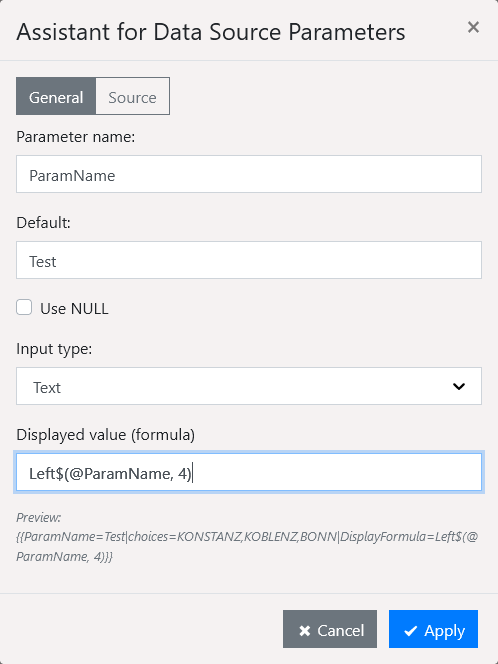
Verbesserungen beim Import von Benutzern aus dem Active Directory
- Nach der Auswahl der Gruppe werden Benutzer nun direkt abgerufen. Bisher musste der Button “Benutzer abfragen” ausgewählt werden.
- Es werden nur aktivierte Benutzer angeboten.
- Ausgewählte Benutzer können schnell wieder entfernt werden – durch einen Klick auf das entsprechende Mülleimer-Symbol.
Erweiterungen des Excel-Exports
Neue Einstellmöglichkeiten beim Excel-Export:
- Der Name des Arbeitsblattes kann eingestellt werden. Es können an dieser Stelle auch Platzhalter verwendet werden.
- Gitternetzlinien können wahlweise ein-/ausgeschaltet werden.
- Endlosseiten können erzeugt werden.
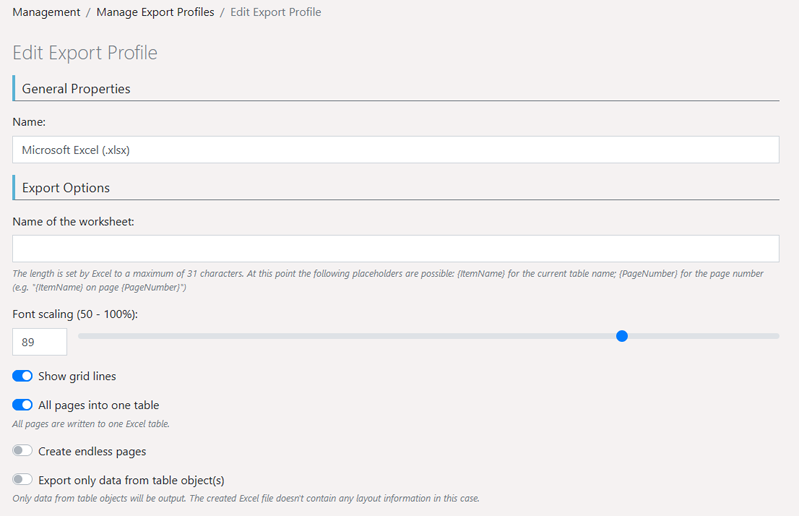
Neue Sprachen für die Oberfläche (l10n)
Die Oberfläche des combit Report Servers und des combit Report Server Designers kann nun wahlweise in Spanisch und Italienisch dargestellt werden.
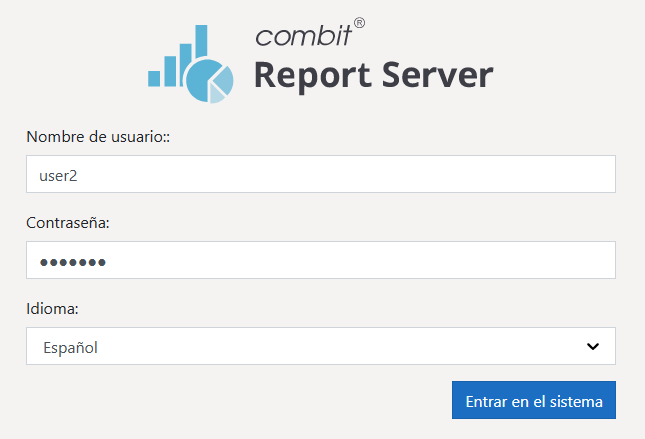
Export-Parameter vorbelegen
Für den “normalen”, interaktiven Export mit Berichtsparametern lassen sich nun, ähnlich wie in unserer REST API, die Parameter vorbelegen. Das ist hilfreich, wenn Sie jemanden einen Link weiterleiten oder in der eigenen Anwendung den Export vom Report Server integrieren wollen. Bisher konnte lediglich die Exportseite für eine bestimmte Berichtsvorlage aufgerufen werden, z.B.:
https://<myserver>/Report/Export/0762CEA0-1929-4C8D-9FAD-1CA17654DEF6
Nun können auch Berichtsparameter an die URL angehängt werden. Der Aufbau ist ähnlich wie bei unserer REST API. Sie müssen den Namen des Parameters (ohne “@”) beginnend mit einem “$” als URL-Parameter anhängen. Nach dem “=” steht der Wert, der vorbelegt werden soll. Bei Auswahlfeldern muss für den Wert der Übergabe der tatsächlich in der Auswahlbox angezeigte Text (LL: “Dargestellter Wert”) verwendet werden. Sie können mehrere Werte mit einem “;” voneinander trennen (Multi-Select). Datums- und Zeitangaben werden prinzipiell im ISO-Format übergeben. Ausnahme hierfür ist die Dropdown-Liste von Datumswerten. Diese müssen mit dem entsprechend angezeigtem Text angegeben werden, z.B.:
https://<myserver>/Report/Export/B2D6B8E3-FF08-4913-B723-4A0C4BAE98F0?$DatasourceSingle=Seafood&$DatasourceMultiple=1;2;3&$Numeric=892&$Text=suhasuh&$Boolean=False&$NonRequiredBoolean=True&$Date=2020-07-02T15:00:00.000Z
Import
Nach dem Import gibt es nun detaillierte Angaben über die angelegten bzw. übersprungenen Objekte. Dadurch haben Sie einen viel besseren Überblick über den Vorgang.
REST API
Auch in diesem Bereich gab es ein paar Erweiterungen. Folgende Aufgaben lassen sich nun durchführen:
- Abfrage der Produktversion
- Import
- Export
Die genaue Dokumentation findet sich wie gewohnt im Handbuch oder der interaktiven Dokumentation:
https://<myserver>/rs27/doc/v1/index.html?url=/rs27/swagger/v1/swagger.json
Systemvoraussetzungen
Der Report Server basiert nun auf .NET 5 und wurde für die folgenden Betriebssysteme optimiert:
- Windows Server 2022
- Windows 11
Neuer Viewer (Vorschau)
Ab dem Service Pack 27.001 wird es eine vollständig neue Vorschau geben. Diese passt sich an die eingestellte Optik (Custom Branding) an und basiert ebenfalls auf React.
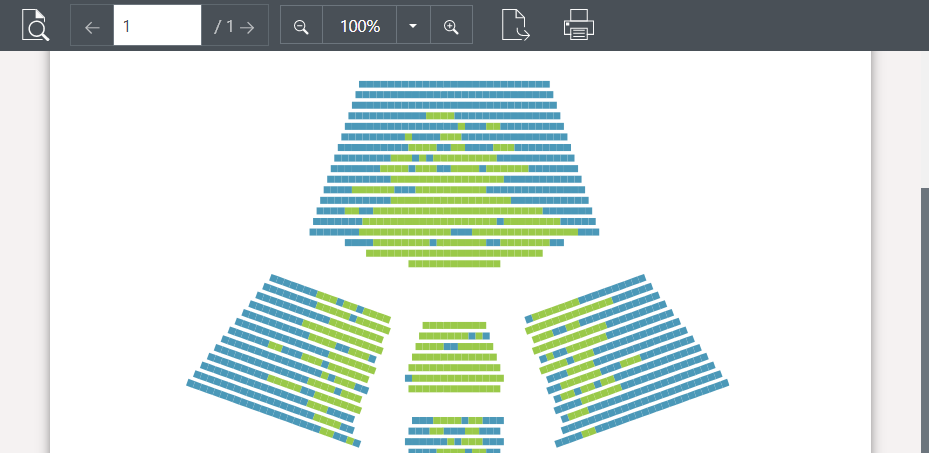
Die Funktionalität ist die gleiche wie beim “alten” Viewer, es gibt jedoch ein weiteres Feature: Sie können nun für die Vorschau ebenfalls Berichtsparameter per URL mitgeben (analog wie beim Export).
Schema in JSON/REST Datenquellen
Ab dem Service Pack 27.001 ist es nun bei einer JSON- und REST-Datenquelle möglich, ein Schema per URL oder Dateipfad vorzugeben. Ein Schema definiert den genauen Aufbau und die Datentypen einer JSON-Datei. Sinnvoll ist diese neue optionale Eigenschaft, wenn sich die JSON-Datei bei jedem Aufruf unterscheiden kann. Ein Beispiel: Der Eintrag CreationTime ist manchmal ein Datum, kann aber auch manchmal null oder einfach nicht vorhanden sein. Damit konnte man bisher nicht den Datentyp des Feldes von Anfang an festlegen, wenn dieses Feld im ersten Datensatz nicht den richtigen Feldinhalt hatte. Weitere Informationen zu dem Thema:
https://json-schema.org/specification
https://datatracker.ietf.org/doc/html/draft-bhutton-json-schema-00
Einschränkung:
Derzeit wird nur ein “FirstSingleSchema” unterstützt, d. h. das Schema wird beispielsweise nicht als AnyOf angegeben, sondern es gibt nur ein festes Schema.
Zusätzlich zu den umfangreichen Neuerungen stehen natürlich auch neue Designer-Features aus List & Label 27 zur Verfügung.
Sie haben gesehen, Kundenwünsche sind uns wichtig. Ich möchte an dieser Stelle gerne nochmals auf unseren Idea Place hinweisen. Hier haben Sie die Möglichkeit, die Zukunft unserer Produkte aktiv mitzugestalten.
For over 20 years Alexander Horak is engaged in software development and has already worked at combit during his computer science studies. Nowadays, he is Head of Development of the combit Report Server, an ASP.NET MVC based Enterprise Reporting solution. In his spare time he loves soccer and is an active supporter of FC Bayern Munich.





